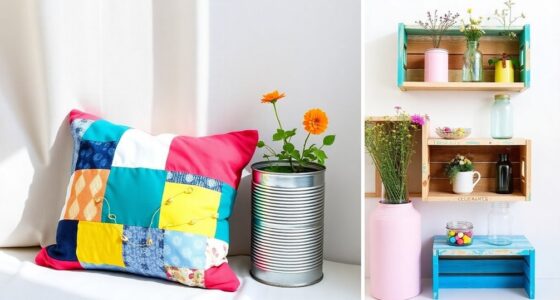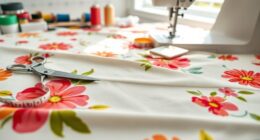A sloper in sewing is your go-to foundational pattern designed to provide a perfect fit based on your unique body measurements. It's essential for creating custom designs that not only look good but also feel great. By focusing solely on fit, slopers let you easily modify and adjust commercial patterns, ensuring a tailored look. You'll find that mastering slopers opens up a world of creative possibilities for your sewing projects. There's so much more to explore!
Key Takeaways
- A sloper is a basic fitting pattern that serves as a template for creating custom garment designs tailored to individual measurements.
- It focuses solely on fit, omitting design details to simplify the pattern alteration process for personalization.
- Common types of slopers include bodice, skirt, and pants, each serving as foundational templates for specific garment styles.
- Hacking techniques allow for creative modifications, such as adjusting hemlines or necklines, while maintaining the original fit.
- Resources like books, online courses, and sloper kits assist in learning and developing custom patterns for unique body shapes.
Understanding the Concept of a Sloper
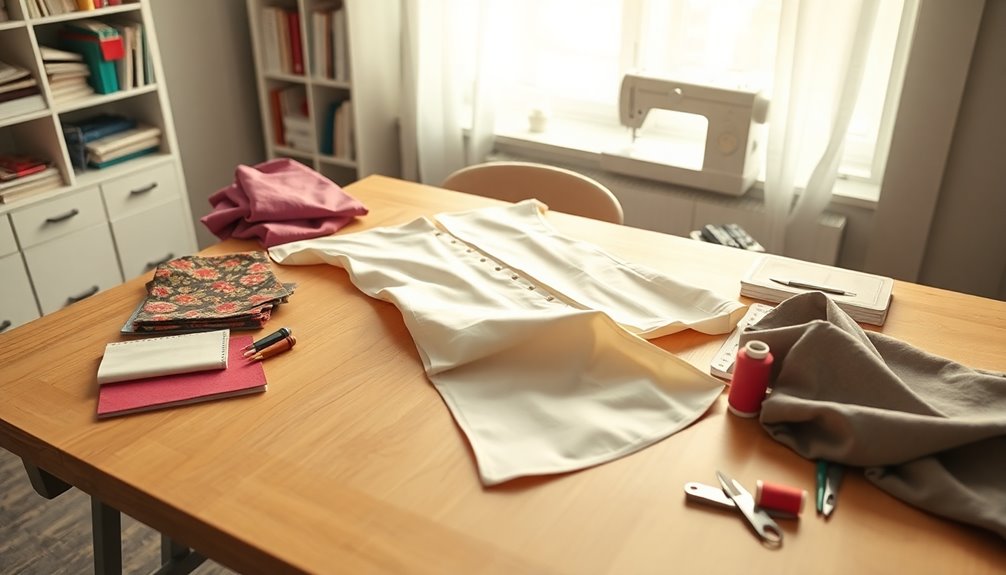
A sloper is your essential blueprint for sewing success, providing a precise fit that reflects your unique body measurements. This foundational pattern, specifically designed for the bodice, skirt, or pants, serves as the starting point in pattern making.
Unlike commercial patterns, a sloper focuses solely on fit, omitting design details and seam allowances to guarantee you can move comfortably. Developing a sloper involves refining it through fitting sessions, often using muslin fabric to tweak any snug or loose areas.
By utilizing a sloper, you simplify the pattern alteration process, allowing you to confidently customize commercial patterns and create new designs that flatter your figure.
Embrace the power of a sloper to elevate your sewing projects!
The Importance of Fit in Garment Construction
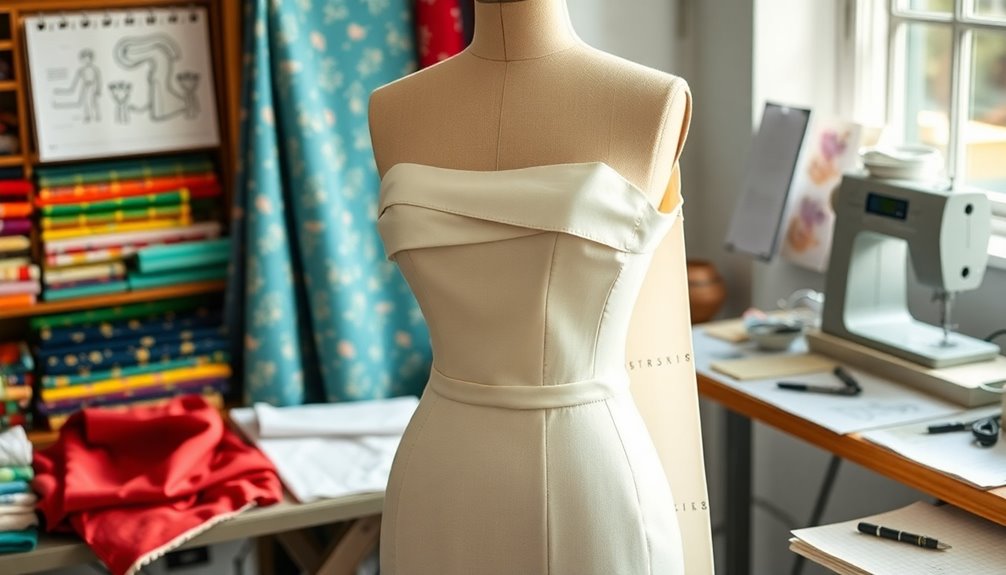
Fit is the cornerstone of successful garment construction, directly impacting how you feel and look in your clothes. Achieving a perfect fit enhances comfort and movement, while a well-fitted sloper acts as your foundational template. By using a sloper to fit your garment pattern, you can make precise alterations tailored to your unique body shape.
| Aspect | Importance | Solution |
|---|---|---|
| Comfort | Enhances wearability | Adjust fit with sloper |
| Movement | Allows freedom of motion | Use muslin for testing |
| Appearance | Flattering silhouette | Customize patterns |
Understanding and addressing fit issues through these techniques is vital for creating professional-quality clothing that meets your style preferences.
Types of Slopers and Their Applications
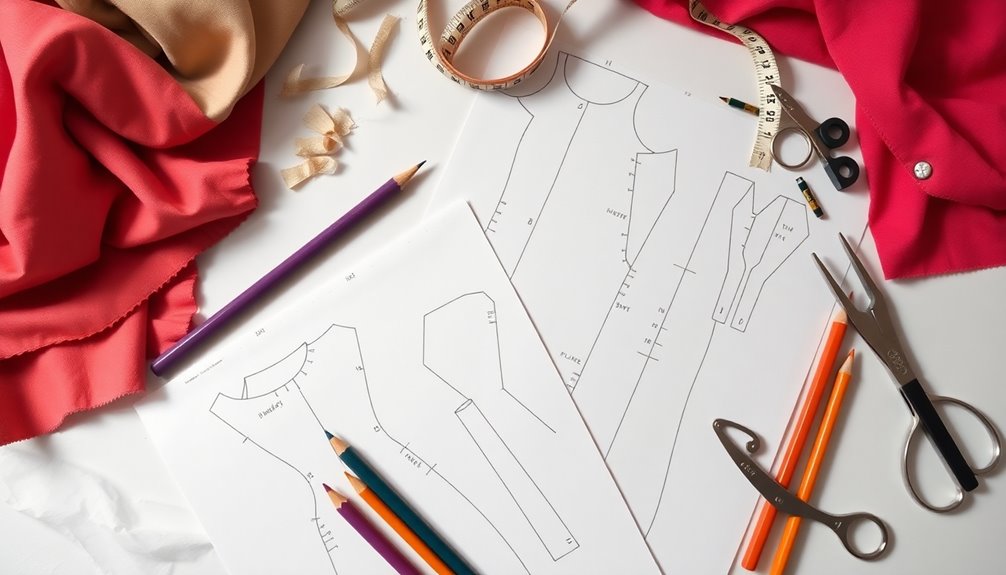
When you start working with slopers, you'll encounter three main types: bodice, skirt, and pants.
Each one serves a specific purpose, helping you create custom-fitted garments that suit various styles.
Bodice Slopers Explained
Bodice slopers serve as the essential building blocks for creating well-fitted garments, allowing you to design tops, dresses, and jackets tailored to individual measurements.
A bodice sloper closely fits your body and includes key measurements like torso length and bust points, ensuring a personalized fit.
By using a sloper to create various styles, you can add sleeves or adjust necklines, making it incredibly versatile. This adaptability means you can maintain the original shape of your design while customizing it to your liking.
Plus, a well-fitted bodice sloper reduces fitting issues during sewing, making the process smoother and more enjoyable.
Embrace the potential of bodice slopers for your custom clothing projects!
Skirt and Pants Variations
Creating stylish and well-fitted skirts and pants starts with understanding the various slopers available. A skirt sloper is perfect for achieving different styles like A-line, pencil, or circle skirts. For pants, you'll find slopers designed for trousers, slacks, and jeans, tailored to fit various body shapes, including flat-butt and curvy-butt versions. You can easily modify these sloper patterns using hacking techniques to create unique designs while ensuring they make it fit perfectly. Additionally, using essential oils for relaxation can help enhance your sewing experience by creating a calming atmosphere.
| Garment Type | Sloper Style | Key Features |
|---|---|---|
| Skirt | A-line | Flared shape |
| Skirt | Pencil | Fitted silhouette |
| Skirt | Circle | Full and flared |
| Pants | Trousers | Classic fit |
| Pants | Jeans | Casual style |
Steps to Create Your Own Sloper
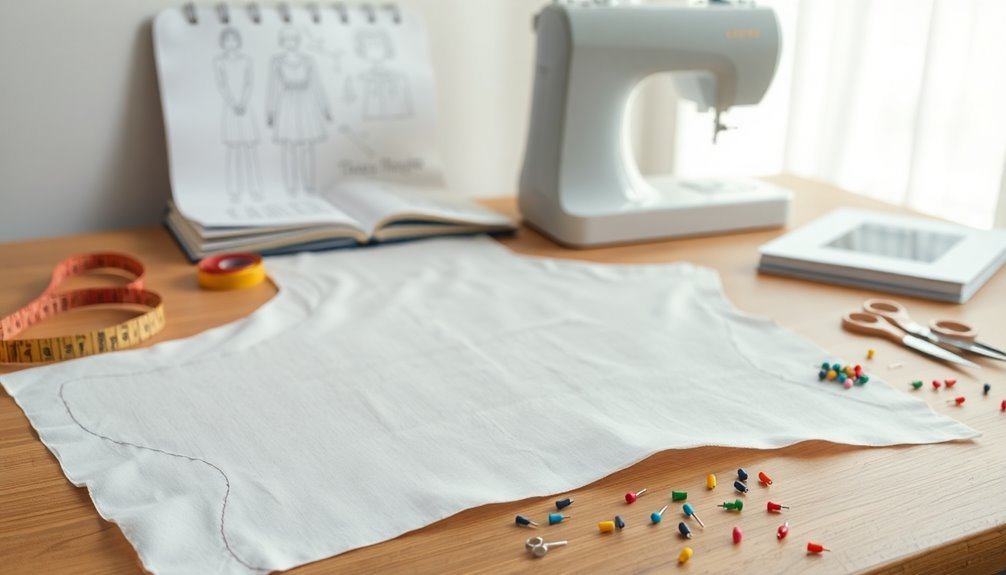
To craft your own sloper, start by taking precise measurements of your body, focusing on key areas like your bust, waist, hips, and torso length. This guarantees a personalized fit.
Next, you can use a pre-designed sloper pattern or a sloper kit to simplify the drafting process. Sew a test sloper from muslin fabric, allowing you to identify snug spots or areas needing adjustments.
As you refine the sloper, make one adjustment at a time, testing it with new muslin pieces after each change. Once you achieve a fitted pattern that suits you, you can confidently use the sloper as a foundation for creating various custom designs, guaranteeing every garment fits perfectly.
How to Achieve the Perfect Fit With a Sloper
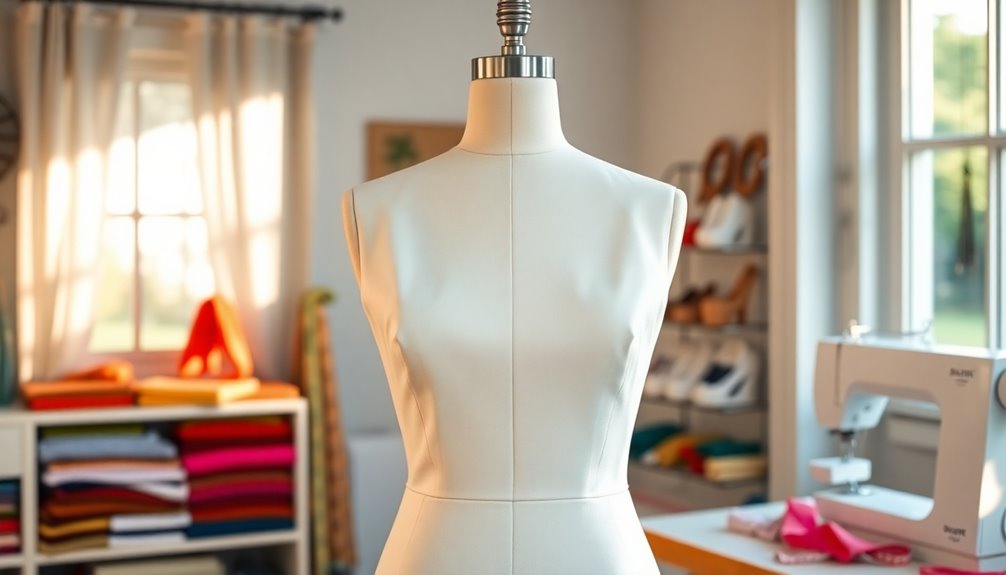
Achieving the perfect fit with a sloper requires careful attention to detail and a willingness to experiment. Start by sewing a muslin version of your sloper to identify snug spots, loose areas, or wrinkles.
You'll want to make incremental adjustments to the sloper, testing each change with new muslin to guarantee improvements in fit. Accurate measurements are essential, as even small discrepancies can greatly affect your final garment's fit.
Use flat pattern adjustments, like raising or lowering darts and altering seam lines, to refine the sloper around your body shape. Regularly compare your sloper with commercial patterns to understand necessary alterations, helping you maintain a consistent fit across different designs and easily alter a pattern for future projects.
Using a Sloper to Modify Existing Patterns
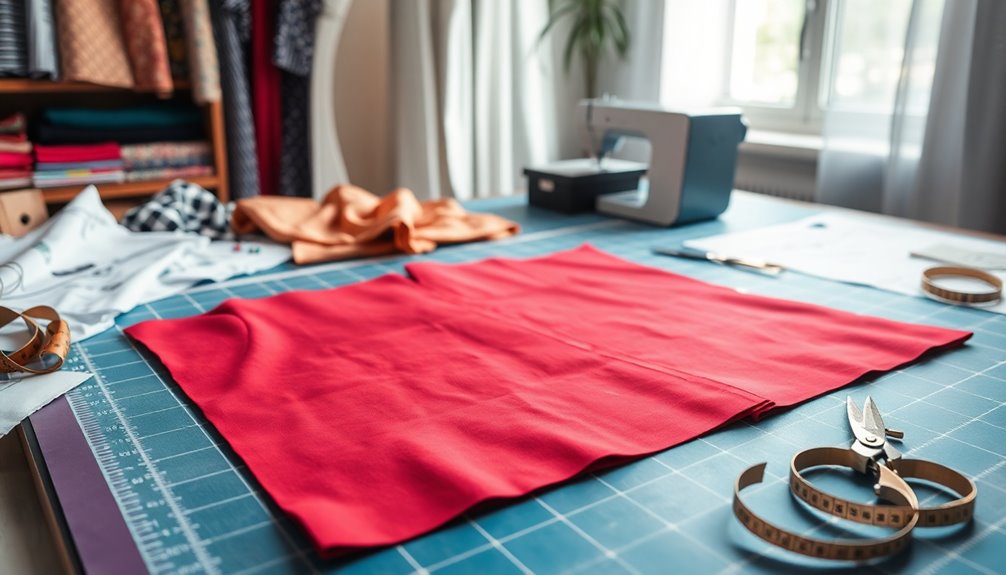
When you want to modify existing patterns, start by aligning your sloper with the commercial pattern for a perfect fit.
Focus on adjusting key details like the shoulders and neckline to match your unique measurements.
This process not only enhances fit but also opens the door for creative pattern hacking.
Pattern Alignment Techniques
Using a sloper as a guide for modifying existing patterns can markedly enhance the fit of your garments.
Start by clearly marking the seamlines on the commercial pattern for reference during adjustments. Next, trace your sloper onto separate tracing or tissue paper to create a working template that retains its original fit.
Align the traced sloper over the commercial pattern, ensuring the center front and center back match accurately. Focus on adjusting the sloper to fit the specific features of the commercial pattern, particularly the shoulders and neckline.
Once you've made your adjustments, secure the tracing to the commercial pattern and cut out the new design, following the lines of the sloper for ideal fit.
Adjusting Fit Details
Adjusting fit details with a sloper allows you to achieve a more personalized garment that flatters your unique shape.
Start by tracing your sloper onto tracing paper to create a template that reflects your measurements. Align this traced sloper with the commercial pattern, making sure key points like bust, waist, and hip lines match for precise fit adjustments.
Next, modify the sloper by adjusting areas needing more room or tightening the fit, such as the shoulders or neckline. Use repositionable glue to secure the sloper to the commercial pattern, allowing for easy alterations without damaging the original.
Once satisfied, cut out the new pattern pieces following the sloper's lines while maintaining the appropriate seam allowances for sewing.
Hacking for Creativity
While a sloper serves as a reliable foundation for your patterns, hacking it opens up a world of creative possibilities. By modifying the basic shape of your sloper, you can create unique garment styles while maintaining a perfect fit.
You can easily adjust design elements like necklines, sleeves, and lengths without losing that tailored feel. Combining different slopers, such as a bodice and skirt, can lead to new designs like dresses with distinct silhouettes.
Hacking techniques, including adding fullness or changing seam placements, allow you to personalize your garments to reflect your style. Utilizing a well-fitted sloper not only boosts your creativity but also simplifies the fitting process, reducing the need for extensive alterations on commercial patterns.
Hacking Your Sloper for Custom Designs
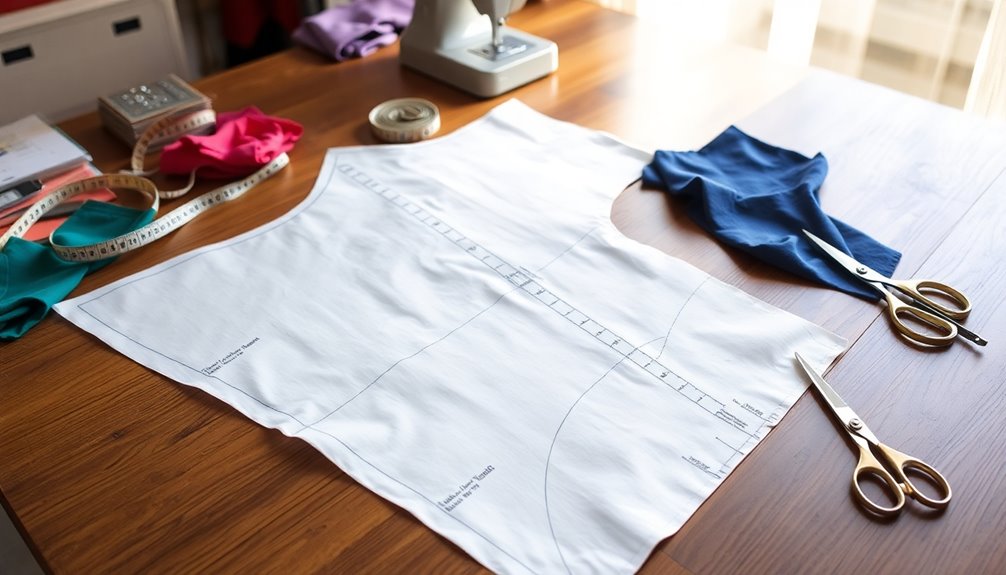
When you want to create unique designs, hacking your sloper offers an exciting way to transform a basic pattern into something that reflects your personal style. You can modify your sloper to make new patterns by adjusting hemlines, changing necklines, or adding sleeves. Just remember to keep the original fit intact with small adjustments.
Here's a quick guide to common hacking techniques:
| Technique | Description |
|---|---|
| Hemline Adjustment | Change the length for a new look |
| Neckline Change | Alter shape for a different vibe |
| Sleeve Modification | Add or remove sleeves |
Document your changes as a tangible record for future projects. This way, you can easily revisit your creative hacks!
Benefits of Employing Slopers in Sewing

Employing slopers in sewing transforms your approach to garment construction by providing a precise foundation for custom-fitted designs. Using slopers not only enhances the fit of your garments but also allows for greater creativity in design adaptations. While advanced techniques can be daunting, experimenting with methods like sewing without a presser foot can yield unique textures and finishes. This approach encourages a deeper understanding of fabric behavior and can lead to truly personalized creations that reflect your sewing style.
With a sloper, you can eliminate the guesswork that often comes with commercial patterns, ensuring a better fit for your unique body shape.
Slopers allow for personalized adjustments, making it easy to modify designs and create diverse styles from a single basic pattern.
This streamlining of the fitting process reduces fitting errors and increases efficiency.
As you master slopers, your skills will improve, enhancing your understanding of pattern alterations and garment construction.
Ultimately, using slopers empowers you to produce custom-fitted garments that reflect your personal style and fit perfectly.
Community Insights on Sloper Usage
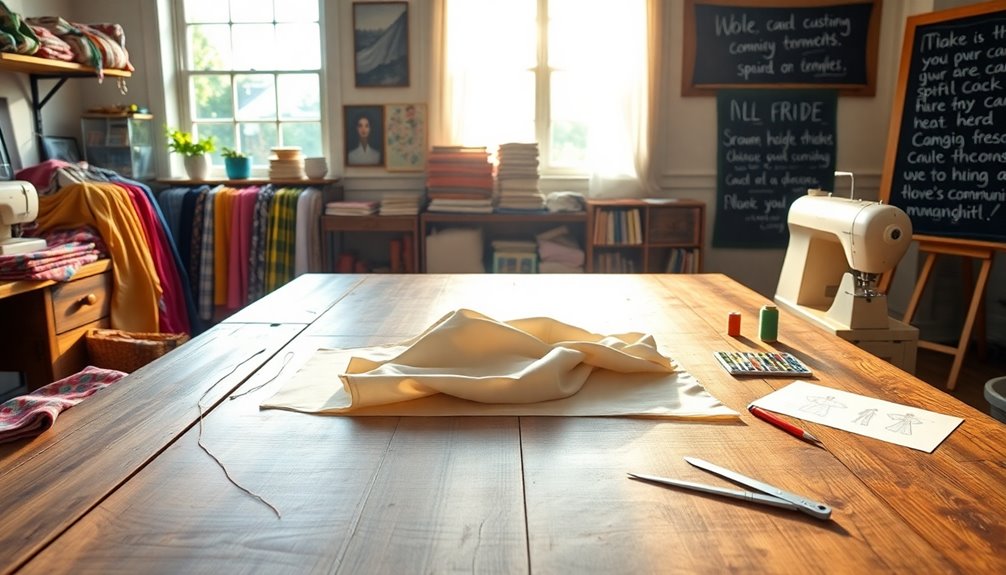
Many sewing enthusiasts have found that using slopers not only enhances their garment fit but also fosters a vibrant community where experiences and techniques are shared.
Engaging with fellow sewists can greatly boost your sewing journey. Here are some insights from the community on sloper usage:
- Improved Fit: Slopers reduce frustrations often faced with commercial patterns.
- Custom Modifications: Sharing sloper modifications helps tackle unique fitting challenges.
- Brand Recommendations: Many recommend Style Arc for innovative pant patterns that work well with slopers.
- Diverse Needs: There's a growing interest in curvy butt slopers, catering to various body types.
Additionally, many sewists emphasize the importance of routine health checks to ensure their slopers remain effective for fit adjustments.
These discussions not only enhance your skills but also build confidence and creativity in your sewing projects.
Resources for Learning More About Slopers

To enhance your understanding of slopers, you'll find a wealth of resources that cater to different learning styles and needs. Here's a quick guide to help you navigate:
| Resource Type | Description |
|---|---|
| Books | *Cut to the Fit* by Karen Howland offers thorough sloper-drafting instructions. |
| Online Courses | "Patternmaking Basics: The Bodice Sloper" by Suzy Furrer provides step-by-step guidance. |
| Sloper Kits | Available from major pattern companies, tailored for various body types. |
| Custom Patterns | Cashmerette's Wyman Dress Sloper serves curvy figures, sizes 0-32, cup sizes C-H. |
| Sewing Communities | Engage in forums for tips on using slopers and commercial patterns. |
These resources will help you master slopers and create your own fitting shell for personalized sewing patterns.
Frequently Asked Questions
What Is a Sloper in Sewing?
A sloper in sewing is your fundamental tool for achieving a perfect fit.
It's a basic pattern that closely follows your body's measurements without any design details. By using a sloper, you can create various garments tailored specifically to your shape.
You'll find it especially useful when modifying commercial patterns, allowing you to trace and adjust them for a more personalized fit.
Basically, it's your foundation for crafting unique clothing that flatters you.
What Is the Difference Between a Sloper and a Pattern Block?
Isn't it fascinating how two terms can shape your sewing journey so differently?
A sloper's your precise, fitted foundation, tailored to your body without design details, while a pattern block acts as a versatile template for various styles.
You'll find that slopers emphasize fit, lacking fullness, whereas pattern blocks allow for creative flourishes.
Understanding this difference empowers you to craft garments that truly reflect your unique style and fit seamlessly.
What Is the Use of Sloper?
A sloper's primary use is to create a well-fitting foundation for your garments.
You can take your sloper and modify it to craft various styles, ensuring that each piece fits your unique body shape perfectly.
It helps eliminate the guesswork in alterations, particularly in tricky areas like pants.
What Is Meant by Sloper?
Imagine trying to fit a puzzle piece that doesn't belong. That's where a sloper comes in.
It's fundamentally a basic, fitted pattern that you can use as a foundation for custom garment designs. You'll find it devoid of extra details, focusing purely on fit.
With various types available, like bodice and skirt slopers, you can create perfectly tailored pieces by modifying this essential template to suit your unique measurements and style preferences.
Conclusion
In sewing, a sloper is your blueprint for success, transforming chaos into precision. By mastering the art of fit, you reveal the potential for custom designs that reflect your unique style. While the process of creating a sloper might seem intimidating, the benefits of perfecting your fit far outweigh the effort. Embrace the journey, experiment with hacking your sloper, and watch your creativity flourish. With each stitch, you're not just sewing; you're crafting your identity.





